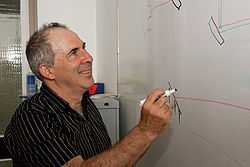Lev Vaidman
| Lev Vaidman | |
|---|---|
 | |
| Born |
September 4, 1955 Leningrad, Soviet Union |
| Residence |
Israel Russia |
| Fields | Physics (theoretical) |
| Institutions | Tel Aviv University |
| Alma mater |
Hebrew University of Jerusalem |
| Known for |
Research of quantum mechanics and quantum information, Elitzur–Vaidman bomb-tester |
Lev Vaidman (born September 4, 1955) is a Russian-Israeli physicist and Professor at Tel Aviv University, Israel. He is noted for his work in the area of quantum teleportation and the Elitzur–Vaidman bomb-testing problem in quantum mechanics. He was a member of the Editorial Advisory Board of The American Journal of Physics from 2007 to 2009.[1] His work and the experiments which they have inspired have lent support to the many-worlds interpretation of quantum physics.[2] In 2010, their experiment was chosen as one of the "Seven Wonders of the Quantum World" by New Scientist Magazine.[3]
Personal life
Vaidman emigrated with his family to Israel at the age of 18. Prior to that, he studied for one year at Saint Petersburg University (then Leningrad University). In 1972, he took first place among Soviet high school students at the Physics Olympiad.[4]
The Elitzur–Vaidman bomb tester
This thought experiment, subsequently conducted in the lab, is an example of interaction-free measurement (IFM). IFM is the detection of the property of an object or its presence without any physical interaction between the observer and the object. Obtaining information from an object in such a manner is paradoxical.
The bomb tester works by employing an interferometer. When a photon is fired into the device, it encounters a half-silvered mirror positioned so as reflect the photon at a ninety-degree angle. There is a 50-50 chance it will be reflected or pass through. Due to the quantum properties of the photon, it both passes through the mirror and is reflected off of it.
Now, the same photon is moving through two different parts of the device. The photon that passed through the mirror is now on the "lower path". It may or may not encounter a bomb, which is designed to explode if it encounters a single photon. The photon that was reflected off the mirror is now on the "upper path". Both photons next encounter a normal mirror. The lower-path photon is reflected ninety-degrees upward (if it did not detect a bomb). The upper-path photon is reflected back ninety degrees so that it is returned to its original trajectory.
IF the lower-path photon did not detect a bomb, it will arrive at a second half-silvered mirror at the same time as the upper-path photon. This will result in the single photon interfering with itself.
A pair of detectors are positioned beyond the mirror in such a way that the photon's superposition collapses and the photon is observed to have either been on the upper path or the lower path, but not both. If the upper-path detector encounters the photon, then the photon "actually" took the upper path and no measurement was made of whether or not there was a bomb on the lower path. If, however, the lower-path detector encounters a photon, it can be determined that fifty percent of the time, there is a bomb on the lower path--without actually encountering it.
According to Hugh Everett's Many-worlds interpretation of quantum physics, there is no paradox. The information was obtained from a parallel universe wherein the encounter between the lower-path photon and the bomb actually did occur. Upon detecting the photon in the end, the device is able to utilize the superposition of the photon to obtain information about the lower path, despite the fact that factually it did not take the lower path.
Teleportation of continuous variables
Vaidman is a pioneer in the area of quantum teleportation. He has demonstrated that non-local measurements can be used to teleport unknown quantum states of systems with continuous variables.[5]
See also
- Avshalom Elitzur
- Elitzur–Vaidman bomb tester
- Englert–Greenberger duality relation
- Interaction-free measurement
- Many-worlds interpretation
References
- ↑ The American Association of Physics Teachers (2009), Annual Report
- ↑ Vaidman, L. (1994), On the Paradoxical Aspects of New Quantum Experiments
- ↑ Seven wonders of the quantum world, newscientist.com
- ↑ "Interview: Testing Bombs, Splitting Worlds and Saving Israel with Professor Lev Vaidman". Joe Hubris. 24 July 2012.
- ↑ Zhang, L., Barhen, J., Liu H., Experimental and Theoretical Aspects of Quantum Teleporation
External links
- Lev Vaidman's homepage
- Publications list
- The Stanford Online Encyclopedia of Philosophy entry on the Many-Worlds Interpretation of Quantum Mechanics, by Lev Vaidman
- Lev Vaidman, Teleportation of Quantum States, Phys. Rev. A 49, 1473-1476 (1994). Pre-print arXiv:hep-th/9305062, submitted 14 May 1993